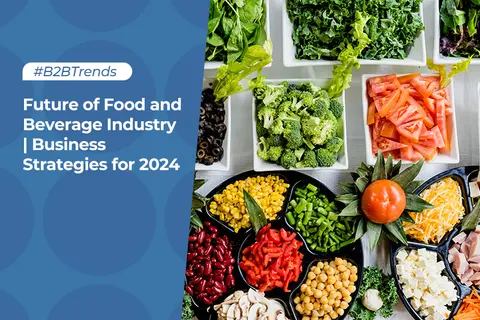Future of Food and Beverage Industry | Business Strategies for 2024

Table of Contents
As times evolve, consumer shopping needs are rapidly changing. In today's society where basic needs are largely fulfilled, consumers have increasingly high demands for food. Before this, we also discussed the overview of foods and beverages in 2024. Therefore, to better meet consumer needs, the food industry faces the daunting task of determining what kind of products to launch and how to upgrade them. Before exploring the future of the food and beverage industry, we should first understand how consumer demands have changed.
What Is the Current Trend For Food And Beverages?
1. Plant-Based Diet:
With increasing concerns about health, environmental conservation, and wellness, plant-based diets are becoming increasingly popular. This is especially friendly for vegetarians. Dietary options like plant-based milk and meat substitutes not only reduce carbon footprints but also offer rich nutrition, catering to various dietary preferences. Therefore, these plant-based diets will be a major selling point.
2. Local and Organic Foods:
The heat surrounding food safety issues has never waned, as people pay extra attention to food quality and safety. Therefore, local and organic foods perfectly meet this demand. Introducing more locally sourced ingredients and organic certified foods not only ensures food quality but also supports local agriculture. This may become one of trends in food and beverage.
3. Functional Beverages:
During the pandemic, issues like dehydration became more common due to fever and coughing. Consequently, functional beverages such as electrolyte water were particularly popular at that time. Nowadays, with more people engaging in fitness activities, the demand for functional beverages is increasing. These beverages not only quench consumers' thirst but also provide them with nutrition, making it a trend in the food and beverage industry of 2024.
4. Packaging Innovation:
With the widespread adoption of environmental protection concepts, people are pursuing eco-friendly shopping methods, such as bringing their own shopping bags and avoiding the use of plastic bags. Therefore, innovating food packaging is urgent. Utilizing biodegradable, renewable, and recyclable materials for packaging food will also win consumers' favor.
5. Innovative Coffee and Tea Formats:
The ready-to-drink coffee and tea market is experiencing continuous expansion as companies introduce novel formats and flavors to captivate consumers' attention. From cold brews to infused teas, the beverage industry is constantly innovating to meet the diverse demands of today's consumers. Creative packaging, unique blends, and convenient serving sizes are just some of the strategies employed to enhance the consumer experience and drive growth in this segment.
6. Consumers' Quest for Alternatives:
Beyond traditional coffee and tea offerings, there's a noticeable trend towards exploring alternatives that offer both flavor and functionality. Beverages like golden milk, which features turmeric and other spices, and spicy teas, infused with ingredients like ginger and cinnamon, are gaining popularity. These alternatives not only provide diverse flavor profiles but also cater to individuals seeking caffeine-free options for health or lifestyle reasons.
7. Sustainability and Ethical Sourcing:
In today's conscientious consumer landscape, sustainability and ethical sourcing have become significant factors driving purchasing decisions. Consumers are increasingly interested in the environmental impact and ethical practices behind the products they consume. As a result, there's a growing demand for food and beverages sourced sustainably and produced with transparency and accountability. Companies are responding by adopting eco-friendly practices, supporting local communities, and implementing fair trade initiatives to meet these expectations.
8. Personalization and Customization:
Advancements in technology, such as 3D printing and artificial intelligence, are revolutionizing the way food and beverages are personalized and customized. These technologies enable manufacturers to create products tailored to individual preferences, whether it's adjusting flavor profiles, nutrient compositions, or even packaging designs. From personalized nutrition shakes to customizable coffee blends, the possibilities for tailored products are endless, offering consumers a unique and personalized experience that resonates with their tastes and preferences.
What Should Food and Beverage Sellers or Suppliers Do?
After learning about consumer food and beverage industry trends, what measures should food suppliers take to enhance their competitiveness?
For online sellers to maintain competitiveness, they should actively respond to these trends by offering consumers the most trending F&B products. Firstly, they can do so by investing in research and development to create and promote plant-based food and beverages. Developing products that satisfy both taste and nutritional value, while strengthening collaboration with agricultural partners, ensures sustainable and high-quality raw material supply.
Secondly, businesses can meet consumer demands for health products by adding vitamins, minerals, antioxidants, and other nutritional ingredients. Additionally, they can offer more options that are low in sugar, low in fat, or free from additives. Furthermore, businesses need to enhance technological innovation by utilizing biodegradable materials, reducing packaging usage, and providing recyclable or reusable packaging options to promote sustainability.
Embrace Plant-Based and Alternative Protein Products:
- Develop and expand offerings in plant-based meat alternatives, dairy substitutes, and other plant-based food and beverage categories to meet increasing consumer demand.
- Innovate beyond traditional burger replacements into new product categories such as snacks, dips, sauces, and more.
Focus on Functional, Healthy, and Sustainable Products:
- Formulate beverages with added nutrients, minerals, herbs, and other functional ingredients to cater to health-conscious consumers.
- Introduce low-alcohol and non-alcoholic "mocktail" options as healthier alternatives to sugary drinks.
- Prioritize natural, recognizable ingredients and minimize processing to align with consumer preferences for transparency and sustainability.
Leverage Technology and Data:
- Utilize AI and data analytics to swiftly identify market opportunities, develop new products, and optimize innovation processes.
- Adopt emerging technologies like 3D printing and personalization to offer customized food and beverage products tailored to individual preferences.
Improve Supply Chain and Operations:
- Address labor shortages and invest in cold chain infrastructure to ensure reliable product delivery.
- Implement strategies to reduce food waste, such as recycling, composting, and energy/water conservation.
Emphasize Transparency and Sustainability:
- Provide clear and comprehensive information about product sourcing, ingredients, and manufacturing processes to build consumer trust.
- Highlight sustainable and ethical business practices to resonate with environmentally-conscious consumers and differentiate your brand in the market.
What Is the Future of Food Technology?
Impact of Food Tech:
- Addressing Global Challenges:
Food tech innovations, such as cellular agriculture, vertical farming, and waste reduction, are helping to tackle issues like food scarcity, hunger, and environmental sustainability. - Market Growth:
The global food tech market is projected to experience significant growth, expanding from $220 billion in 2019 to over $345 billion by 2027. - Transformation of the Food Value Chain:
Food tech is reshaping the entire food value chain, revolutionizing processes from production to distribution to consumption
Trends in Food Tech:
- Plant-Based and Alternative Proteins:
The rising demand for vegetarian/vegan options and awareness of health and environmental benefits are driving the growth of plant-based foods and alternative proteins. - Personalized Diets and Customized Food Products:
Emerging technologies like 3D printing and AI are facilitating the creation of tailored food products and personalized diets. - Food Delivery Services and Apps:
Food delivery services and apps are transforming the way food is distributed and consumed, offering convenience and accessibility to consumers. - Advancements in Agricultural Technology:
Innovations in agricultural robotics, precision farming, and food science are enhancing food production efficiency and sustainability.
Conclusion
Based on the aforementioned consumer demands, food and beverage suppliers should introduce plant-based food options to cater to various dietary preferences. At the same time, they should prioritize the quality and safety of food and launch health-oriented products.
Additionally, attention should be paid to functionality to meet consumers' further needs. It is worth noting that sustainability and eco-friendly packaging have also become important topics in the industry. Companies should innovate and improve food packaging from an environmental perspective, preventing over-packaging and environmental pollution.
In conclusion, if a company wishes to continue its sustainable development, it is essential to understand the trends of consumers in the food and beverage industry. This trend guide can provide assistance to these enterprises, promoting them to optimize and upgrade their products, and achieve transformation. In the future, the food and beverage industry will see emerging trends that place greater emphasis on nutritional value, health, and safety.
Start your borderless business here
Tell us about your business and stay connected.
Keep up with the latest from Alibaba.com?
Subscribe to us, get free e-commerce tips, inspiration, and resources delivered directly to your inbox.















